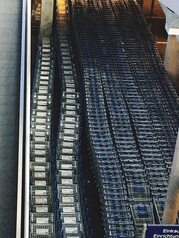The influence of urban mobility on emerging value.

Urban mobility is a key factor that transforms emerging areas into true development epicenters. As cities evolve, their infrastructure and connectivity directly influence the appreciation of land and properties. Understanding this relationship is essential for those looking to invest in the Costa Rican real estate market. In this article, we will explore how urban mobility impacts the valuation of emerging areas, providing valuable information for making informed decisions.
1. Definition of urban mobility and its importance in urban development
Urban mobility refers to the ability of people to move within a city efficiently and accessibly. This concept encompasses not only public transport but also pedestrian infrastructure, bike lanes, and connectivity between different modes of transport. Proper planning in urban mobility allows citizens to easily access services, jobs, and cultural activities, which in turn enhances the quality of life in urban areas. As these systems develop and improve, they create a positive impact on the perception and value of surrounding properties.
The importance of urban mobility in urban development lies in its ability to foster balanced and sustainable growth. When an area has an efficient transportation system, it attracts both residents and businesses, thus driving its economic dynamism. This translates into a higher appreciation of the land and properties located in these areas, making them attractive options for investors and buyers. In this sense, understanding how urban mobility works is crucial for anticipating real estate market trends, especially in emerging areas that are beginning to experience significant changes due to improvements in their road and transportation infrastructure.
2. Emerging areas: characteristics and investment opportunities
Emerging areas are characterized by their potential for growth and development, largely driven by the improvement of urban mobility infrastructure. These areas often feature a combination of accessible land, expanding basic services, and a transforming urban environment. As new public transportation routes, roads, or bike lanes are implemented, connectivity with the center and other key points of the city increases, attracting both residents and businesses. This phenomenon not only enhances the quality of life for inhabitants but also elevates the appeal for investors looking to capitalize on these opportunities before prices soar.
Investing in emerging areas represents a smart strategy for those looking to diversify their real estate portfolio. Since these areas can still offer lower prices compared to established zones, there is high potential for achieving significant returns in the medium and long term. Additionally, being located near future infrastructure projects or projected commercial developments, these regions tend to experience a considerable increase in their value. Therefore, understanding how urban mobility affects these changes is essential for identifying the best opportunities and minimizing risks when investing in the Costa Rican real estate market.
3. How transportation infrastructure affects real estate appreciation
Transportation infrastructure plays a fundamental role in the dynamics of the real estate market, especially in emerging areas. When new roads, public transport systems, or strategic connections are developed, accessibility improves significantly. This improvement not only facilitates the daily commuting of residents but also attracts businesses and services looking to benefit from a higher flow of people. As a result, properties located in these areas tend to experience a significant increase in their appreciation, as the demand for housing and commercial spaces rises with the perception of better connectivity to the rest of the city.
Additionally, urban planning plays a crucial role in this relationship between transportation and real estate investment. Projects that integrate green spaces, pedestrian paths, and bike lanes not only promote a healthy lifestyle but also enhance the overall appeal of the area. Investors and buyers often seek properties in environments where access to transportation is efficient and convenient; this translates into faster and more sustainable appreciation over time. Therefore, understanding how transportation infrastructure interrelates with market trends can be decisive for those looking to maximize their real estate investment within the Costa Rican context.
4. Successful cases: cities that have grown thanks to improvements in mobility
Cities that have implemented significant improvements in their urban mobility have seen a notable increase in their property value. A clear example is Medellín, Colombia, where the creation of the metro system and the innovative Metrocable have transformed previously marginalized neighborhoods into vibrant and attractive areas to live and invest in. The efficient connection between different areas has allowed new businesses to thrive, attracting both residents and tourists. This comprehensive approach has not only improved access to transportation but has also fostered a sense of community and social cohesion, which translates into an increase in property values.
Another successful case is that of Curitiba, Brazil, known for its Bus Rapid Transit (BRT) systems that have revolutionized the way residents move around the city. Public transport-centered urban planning has led to increased population density and a significant improvement in quality of life. Real estate developments around BRT stations are experiencing a boom, as buyers seek to take advantage of the convenience of access to fast and efficient transportation. This model has proven to be a catalyst for local economic growth and an effective way to increase property value in areas previously considered peripheral.
5. The role of public transportation in property valuation
Public transportation plays a fundamental role in property valuation, especially in emerging areas. The accessibility provided by mass transit systems, such as buses, trains, and subways, not only facilitates the daily commute of residents but also improves connectivity between different parts of the city. This translates into greater appeal for potential buyers and investors, who value convenience and efficiency when traveling. As transportation routes expand or improve, properties near these corridors tend to experience a significant increase in their value.
Additionally, the development of public transportation is often accompanied by improvements in urban infrastructure, such as parks, public spaces, and commercial services. These investments create a more attractive and functional environment for residents, thereby elevating the quality of life in the area. Properties located near transportation stations tend to be perceived as more desirable due to their convenience, which often results in greater competition from interested buyers. In this sense, understanding the impact of public transportation can be crucial for those looking to maximize their investment in the Costa Rican real estate market.
6. Current trends in urban mobility and their future impact
Urban mobility is undergoing a significant transformation, driven by technological innovations and changes in citizen preferences. The rise of bike-sharing, electric scooters, and transportation apps has redefined how we move within cities. These trends not only facilitate commuting but also promote a more sustainable and accessible lifestyle. As these options are integrated into urban infrastructure, areas lacking connectivity begin to lose appeal, while those focused on efficient mobility rapidly gain value.
The future impact of these trends goes beyond the simple increase in real estate value; it also affects urban planning and quality of life. Areas that implement efficient public transportation systems and pleasant pedestrian spaces tend to attract investments and promote greater commercial development. This creates a positive cycle where better mobility options lead to higher residential demand, which in turn raises land prices and improves the overall perception of the area. Understanding these dynamics is crucial for those looking to capitalize on growth in emerging markets like Costa Rica.
7. Strategies to identify emerging areas with high potential
To identify emerging areas with high potential, it is essential to observe urban mobility trends in the region. Areas that are experiencing improvements in their transportation infrastructure, such as new bus routes, road expansions, or the implementation of light rail systems, are often key indicators of future growth. Additionally, the development of bike lanes and pedestrian spaces not only facilitates access to these areas but also makes them more attractive places to live and work. Analyzing these changes can provide a clear insight into where a significant increase in real estate demand is expected.
Another crucial aspect is to consider urban planning and government projects that promote sustainable development in certain areas. The creation of parks, cultural centers, and nearby recreational spaces can transform an undervalued area into a desirable place to live. Additionally, it is important to research demographic and economic projections; an increase in the young or professional population can drive demand for housing and local services. Conducting studies on these factors will enable investors to make informed decisions and seize opportunities in emerging markets before they appreciate significantly.
8. The influence of urban design on perceived value
Urban design plays a crucial role in how the value of an area is perceived, as it affects not only the functionality of the space but also its aesthetic and social appeal. Well-planned areas, with access to efficient public transportation, green spaces, and adequate services, tend to attract both residents and investors. When a neighborhood has an urban design that prioritizes sustainable mobility and accessibility, its demand increases, which in turn raises property prices. The perception of value is not limited solely to physical aspects; it also includes the quality of life that these environments can offer.
Additionally, urban design can influence the construction of cohesive and vibrant communities. Areas that promote community and social activities generate a sense of belonging among their residents, which is highly valued by potential buyers and tenants. The integration of commercial, cultural, and recreational spaces in urban planning contributes to creating an attractive environment for living and investing. Thus, by improving infrastructure and design in emerging areas, it enhances not only real estate value but also the comprehensive development of the place, turning it into a preferred destination within the real estate market.
9. Practical tips for investors interested in emerging areas.
For investors interested in emerging areas, it is essential to stay informed about urban mobility trends that affect the valuation of these areas. Observing how new infrastructures, such as roads, public transportation, and bike lanes, develop can provide clues about the future growth of an area. Additionally, attending community meetings or consulting with local experts can provide valuable information about planned projects that could influence property appreciation. This type of research allows for anticipating significant changes in the market and positioning strategically.
Diversifying investments in different types of properties within these emerging areas can be a prudent approach. Considering both residential and commercial options offers the opportunity to benefit from the economic growth driven by increased urban mobility. It is also advisable to evaluate the demographic and socioeconomic profile of future residents to ensure there is demand for the specific types of properties planned for acquisition. By adopting this proactive and analytical approach, investors can maximize their opportunities in an increasingly competitive and dynamic real estate market.



